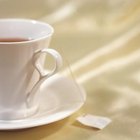
Whether you prefer loose leaf tea or tea bags, there will be an expiration date on every container you buy. Both types of tea start with the same plant, which is called Camellia sinensis, but the leaves go through more processing to get to the fine, powder-like texture in tea bags. Trying to determine if that expiration date on the package really means anything can be confusing.
Tea Expiration Dates
Both loose leaf tea and tea bags usually have an expiration date on the packaging, but usually that date is pretty far into the future. It's not uncommon to see expiration dates that are two or even three years away. A tea that has passed its expiration date and gone "bad" loses its flavor and you can no longer smell the leaves.This is from the natural oils present in the leaves evaporating. If this has happened to you, try adding more bags or leaves to the pot to extract as much flavor out as you can, before just discarding them.
Food Borne Illnesses
While the expiration dates are a quality issue, that doesn't mean you can't encounter health issues when dealing with tea. Like with any product in the kitchen, it is important to practice correct hygiene and kitchen safety techniques. As an example; handling raw meats when preparing dinner and then grabbing some tea leaves or a tea bag to brew a cup can still transfer dangerous bacteria, even though the leaves are dried and the expiration date isn't a big issue. The tea may not taste as strong as it commonly is, or may taste slightly bitter.
Proper Storage
If you're a connoisseur who loves the taste of your tea, take care to store it properly for a longer shelf life. Use a container that won't absorb odors or flavors easily, like non-reactive metals and glazed ceramics. Try to avoid using wooden containers or plastic sandwich bags, because these can lower the quality and shorten the shelf life of the tea. Whether you're using bags or leaves, store the tea in a cupboard or drawer that is dry, cool and dark and in a container that is airtight.
Using Up the Excess
The best way to get around tea expiration dates and quality issues is to only buy quantities that you know you'll use before that date arrives. However, if you find that there are leaves or bags left over, you can use it for something else if you're concerned about drinking lower-quality tea. You can use tea bags as a cosmetic treatment to reduce puffy eyes by wetting them with cold water and placing them over your eyes for roughly 20 minutes. You can also use your excess tea bags or leaves to remove unpleasant odors from your dresser drawers, closets or suitcases by placing them inside and letting them go to work.
Related Articles

How to Use Leftover Tea Leaves

How to Get Rid of Eye Bags Using Green ...

How to Make Calendula Tea

How to Tenderize Meat With Tea

How to Make Loose Tea in a Coffee Pot

How to Restore Gray Hair With Kombucha

Instructions for the West Bend Ice Tea ...

Teas That Stop Facial Hair Growth

How to Make Plant Shampoo Using Soap ...

How to Get Rid of an Ant Nest in the ...

Is Rooibos Tea Good for Acne?

How to Make Goji Berry Tea

How to Get Rid of Light Colored Bags ...

Types of Biodegradable Products

How to Blanch Kale for Freezing

Green Tea Remedy for Blackheads

Uses for Grapefruit Peel

Uses for Mothballs

How to Dry Papaya Leaf for Tea

Can Herbs Flush Cellulite?
References
Writer Bio
Joshua McCarron has been writing both online and offline since 1995. He has been employed as a copywriter since 2005 and in that position has written numerous blogs, online articles, websites, sales letters and news releases. McCarron graduated from York University in Toronto with a bachelor's degree in English.
Photo Credits
ULTRA F/Digital Vision/Getty Images